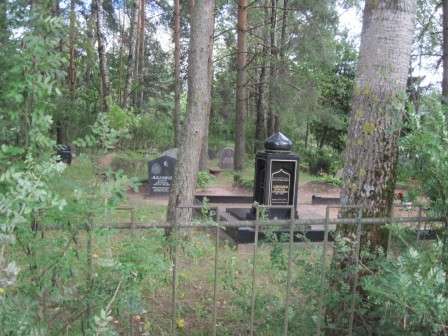Jakobstadt Jewish cemetery (2016)
By System Admin on Sunday, November 22 2020, 19:21 - New material - Permalink
In the chapter "Three communities in twenty crates…", Avraham Shpungin mentions that during the war, muslim Tatars who arrived with the Germans retreating from Russia began using part of the Jewish cemetery in Jakobstadt.
The muslim section is obviously the newest and the first part one sees entering the cemetery in 2016.
Mr. Shpungin describes in detail how in the 1950s, the Jews remaining from Jakobstadt and neighboring towns exhumed the bodies of their loved ones from the killing pits of Kūkas and had them reinterred in a mass grave in the Jakobstadt Jewish cemetery.
The mass grave and memorial are the next newest and second part of the cemetery one sees.
When Mr. Shpungin left Latvia for Israel in 1971, he made one last visit to the cemetery to find that the Star of David had been filed off the memorial.
It remains visibly filed off. Perhaps the file mark itself may now be considered part of the memorial.
He described the cemetery then as "neglected and abandoned."
Walking deeper into the cemetery is like walking backwards in time.
The cemetery is larger than it first appears. There are few Jews in the area today, but the community dates back more than two hundred years. Like many other towns in Selonia and Latgale, the Jewish community here once comprised close to half of the local population. Many of the stones, where the writing was still legible, read האיש התם "the simple man" or האישה הצנועה "the modest woman." May we all live to earn such praises.
The farther reaches of the cemetery appear to be returning to a state of nature.
Some 12km northwest of Jakobstadt is the killing site at Kūkas. Mr. Shpungin says that at the time of the killings there had been peat bogs at this location and the Jews had been made to dig peat there before being killed. Today it is a wooded area.
This is a picture Mr. Shpungin includes in the Hebrew edition of the book, after his visit to Latvia in 1993. He notes that newer memorials now feature a Star of David and can specifically mention Jews. However, this one apparently dates from the Soviet period since he notes: "Here too, the Soviets avoided mentioning the name “Jews”."
This is how we found it in 2016. Mr. Shpungin describes "three or four pits that were 10 to 12 meters long." Such a trench is visible to the right.







